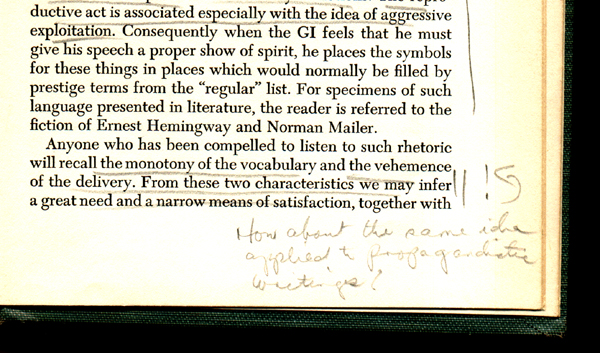|
My
copy of Richard Weaver's The Ethics of Rhetoric is the first
edition published by Henry Regnery in 1953. The copy is not pristine,
as some book collectors would like. One previous owner graced every
page, student-wise, with abundant, dutiful underlining. The reader left
the margins clear, though—except for a couple of spots. One happens
to date the reading as 1966. The other is more interesting.
Weaver's last chapter, "Ultimate Terms in Contemporary
Rhetoric,"is very forceful, even caustic. Joining other rhetoricians
and semanticists who were instructed by the Second World War, he condemns
the ways those in power manipulate the public through language. He analyzes
"god terms" and "devil terms" (one of his god terms,
technical-writing teachers might be surprised to note, is "efficiency").
Toward the end of the chapter (page 225), he draws some examples from
U. S. military language or what he calls, borrowing a phrase from Kenneth
Burke, "the image of killing." He notes how some of the imagery
is identified with "faeces and the act of defecation," as
in the military/government term "elimination," and how "the
reproductive act is associated especially with the idea of aggressive
exploitation." He asks the reader to recall "the monotony
of the vocabulary and the vehemence of the delivery" characteristic
of the speech of GIs. At this point my reader can't hold silent any
more. Two vertical lines are slashed in the right-hand margin, and then
an exclamation point, and below is written, "How about the same
idea applied to propagandistic writings?" The reader rebels! I
wonder if this one remembered the outburst seven pages later on
reading Weaver's concluding words to the chapter: "It is worth
considering whether the real civil disobedience must not begin with
our language."
What
I find worth considering is why composition and rhetorical studies
show a near absence of interest in marginalia. Literary scholars,
of course, have thoroughly analyzed and faithfully reproduced the marginalia
of famous writers—Edward de Vere, Samuel Taylor Coleridge, Katherine
Anne Porter, a hundred others (for a delightful read on the topic, try
H. J. Jackson's Marginalia: Readers Writing in Books, Yale
University Press, 2001). But the dynamics of ordinary readers as they
scribble in margins and between lines has never been studied. No doubt
the typical reader's marginal repartee lacks the punch of William Blake
verbal uppercuts ("Thus Fools quote Shakespeare," "Surely
the Man who wrote this never talkd to any but Coxcombs"). But discourse
analysis could still find plenty to analyze. Consider just the graphic
effects of the above gloss: the angry vertical slashes, the accusatory
arrow, the exclamation-point emoticon. . . .
In
Ex Libris: Confessions of a Common Reader (1998), one
of my favorite books about bibliomania, Anne Fadiman divides collectors
into two sorts, the "courtly lovers of books," who maintain
their volumes in pristine condition, and the "carnal lovers of
books," who underline and circle, jot in the margins and end-pages,
dog-ear pages to mark favorite passages, in short, talk back. I'm of
the second sort, and feel my first edition of The Ethics of Rhetoric
all the more valuable for the traces one previous owner left of a momentary
encounter 38 years ago when the normal etiquette of silence between
author and reader collapsed.
RH,
June 2004
|
